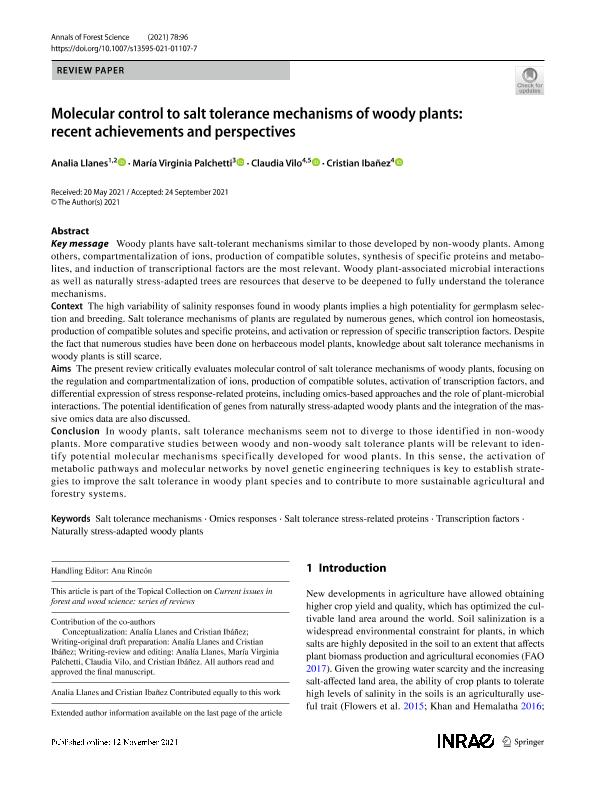Mostrar el registro sencillo del ítem
dc.contributor.author
Llanes, Analia Susana

dc.contributor.author
Palchetti, Maria Virginia

dc.contributor.author
Vilo, Claudia
dc.contributor.author
Ibáñez, Cristian

dc.date.available
2022-10-04T13:03:23Z
dc.date.issued
2021-12
dc.identifier.citation
Llanes, Analia Susana; Palchetti, Maria Virginia; Vilo, Claudia; Ibáñez, Cristian; Molecular control to salt tolerance mechanisms of woody plants: Recent achievements and perspectives; EDP Sciences; Annals of Forest Science; 78; 4; 12-2021; 1-19
dc.identifier.issn
1286-4560
dc.identifier.uri
http://hdl.handle.net/11336/171670
dc.description.abstract
Key message: Woody plants have salt-tolerant mechanisms similar to those developed by non-woody plants. Among others, compartmentalization of ions, production of compatible solutes, synthesis of specific proteins and metabolites, and induction of transcriptional factors are the most relevant. Woody plant-associated microbial interactions as well as naturally stress-adapted trees are resources that deserve to be deepened to fully understand the tolerance mechanisms. Context: The high variability of salinity responses found in woody plants implies a high potentiality for germplasm selection and breeding. Salt tolerance mechanisms of plants are regulated by numerous genes, which control ion homeostasis, production of compatible solutes and specific proteins, and activation or repression of specific transcription factors. Despite the fact that numerous studies have been done on herbaceous model plants, knowledge about salt tolerance mechanisms in woody plants is still scarce. Aims: The present review critically evaluates molecular control of salt tolerance mechanisms of woody plants, focusing on the regulation and compartmentalization of ions, production of compatible solutes, activation of transcription factors, and differential expression of stress response-related proteins, including omics-based approaches and the role of plant-microbial interactions. The potential identification of genes from naturally stress-adapted woody plants and the integration of the massive omics data are also discussed. Conclusion: In woody plants, salt tolerance mechanisms seem not to diverge to those identified in non-woody plants. More comparative studies between woody and non-woody salt tolerance plants will be relevant to identify potential molecular mechanisms specifically developed for wood plants. In this sense, the activation of metabolic pathways and molecular networks by novel genetic engineering techniques is key to establish strategies to improve the salt tolerance in woody plant species and to contribute to more sustainable agricultural and forestry systems.
dc.format
application/pdf
dc.language.iso
eng
dc.publisher
EDP Sciences

dc.rights
info:eu-repo/semantics/openAccess
dc.rights.uri
https://creativecommons.org/licenses/by/2.5/ar/
dc.subject
NATURALLY STRESS-ADAPTED WOODY PLANTS
dc.subject
OMICS RESPONSES
dc.subject
SALT TOLERANCE MECHANISMS
dc.subject
SALT TOLERANCE STRESS-RELATED PROTEINS
dc.subject
TRANSCRIPTION FACTORS
dc.subject.classification
Ciencias de las Plantas, Botánica

dc.subject.classification
Ciencias Biológicas

dc.subject.classification
CIENCIAS NATURALES Y EXACTAS

dc.title
Molecular control to salt tolerance mechanisms of woody plants: Recent achievements and perspectives
dc.type
info:eu-repo/semantics/article
dc.type
info:ar-repo/semantics/artículo
dc.type
info:eu-repo/semantics/publishedVersion
dc.date.updated
2022-09-20T18:40:01Z
dc.identifier.eissn
1297-966X
dc.journal.volume
78
dc.journal.number
4
dc.journal.pagination
1-19
dc.journal.pais
Francia

dc.journal.ciudad
Paris
dc.description.fil
Fil: Llanes, Analia Susana. Universidad Nacional de Rio Cuarto. Facultad de Cs.exactas Fisicoquimicas y Naturales. Instituto de Investigaciones Agrobiotecnologicas. - Consejo Nacional de Investigaciones Cientificas y Tecnicas. Centro Cientifico Tecnologico Conicet - Cordoba. Instituto de Investigaciones Agrobiotecnologicas.; Argentina. Universidad Nacional de Río Cuarto. Facultad de Ciencias Exactas Fisicoquímicas y Naturales. Departamento de Ciencias Naturales. Laboratorio de Fisiología Vegetal y de la Interacción Planta-microorganismo; Argentina
dc.description.fil
Fil: Palchetti, Maria Virginia. Consejo Nacional de Investigaciones Científicas y Técnicas. Centro Científico Tecnológico Conicet - Córdoba. Instituto Multidisciplinario de Biología Vegetal. Universidad Nacional de Córdoba. Facultad de Ciencias Exactas Físicas y Naturales. Instituto Multidisciplinario de Biología Vegetal; Argentina
dc.description.fil
Fil: Vilo, Claudia. Universidad de La Serena; Chile. Universidad de Antofagasta; Chile
dc.description.fil
Fil: Ibáñez, Cristian. Universidad de La Serena; Chile
dc.journal.title
Annals of Forest Science

dc.relation.alternativeid
info:eu-repo/semantics/altIdentifier/doi/https://doi.org/10.1007/s13595-021-01107-7
dc.relation.alternativeid
info:eu-repo/semantics/altIdentifier/url/https://annforsci.biomedcentral.com/articles/10.1007/s13595-021-01107-7
Archivos asociados
